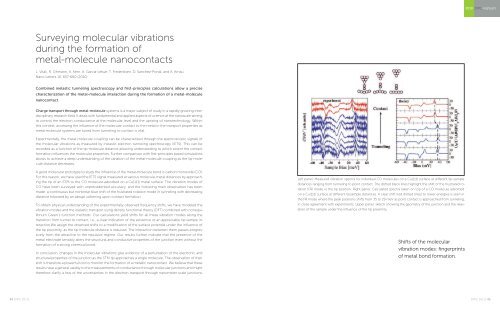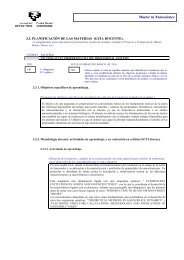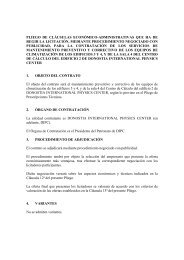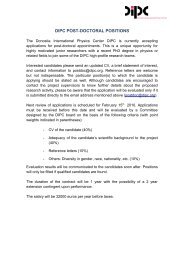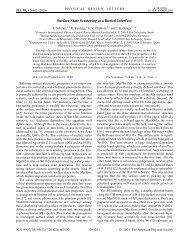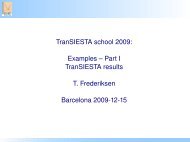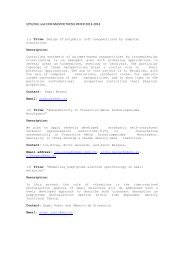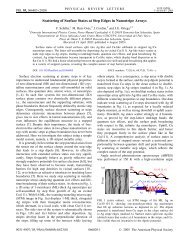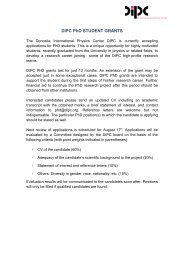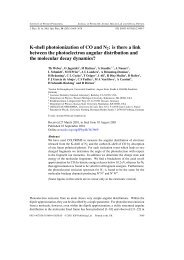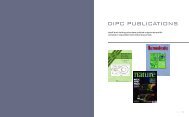Complete report - Donostia International Physics Center - Euskal ...
Complete report - Donostia International Physics Center - Euskal ...
Complete report - Donostia International Physics Center - Euskal ...
You also want an ePaper? Increase the reach of your titles
YUMPU automatically turns print PDFs into web optimized ePapers that Google loves.
2010 DIPC Highlight<br />
Surveying molecular vibrations<br />
during the formation of<br />
metal-molecule nanocontacts<br />
L. Vitali, R. Ohmann, K. Kern, A. Garcia-Lekue, T. Frederiksen, D. Sanchez-Portal, and A. Arnau<br />
Nano Letters 10, 657-660 (2010)<br />
Combined inelastic tunneling spectroscopy and first-principles calculations allow a precise<br />
characterization of the metal-molecule interaction during the formation of a metal-molecule<br />
nanocontact.<br />
Charge transport through metal-molecule systems is a major subject of study in a rapidly growing interdisciplinary<br />
research field. It deals with fundamental and applied aspects of science at the nanoscale aiming<br />
to control the electron conductance at the molecular level and the uprising of nanotechnology. Within<br />
this context, accessing the influence of the molecular contact to the metal in the transport properties as<br />
metal-molecule systems are tuned from tunneling to contact is vital.<br />
Experimentally, the metal-molecule coupling can be characterized through the spectroscopic signals of<br />
the molecular vibrations as measured by inelastic electron tunneling spectroscopy (IETS). This can be<br />
recorded as a function of the tip-molecule distance allowing understanding to which extent the contact<br />
formation influences the molecular properties. Further comparison with first-principles based simulations<br />
allows to achieve a deep understanding of the variation of the metal-molecule coupling as the tip-molecule<br />
distance decreases.<br />
A good molecular prototype to study the influence of the metal-molecule bond is carbon monoxide (CO).<br />
For this reason, we have used the IETS signal measured at various molecule-metal distances by approaching<br />
the tip of an STM to the CO molecule adsorbed on a Cu(111) metal surface. The vibration modes of<br />
CO have been surveyed with unprecedented accuracy, and the following main observation has been<br />
made: a continuous but nonlinear blue shift of the frustrated rotation mode in tunneling with decreasing<br />
distance followed by an abrupt softening upon contact formation.<br />
To obtain physical understanding of the experimentally observed frequency shifts, we have modeled the<br />
vibration modes and the inelastic transport using density functional theory (DFT) combined with nonequilibrium<br />
Green’s function methods. Our calculations yield shifts for all these vibration modes along the<br />
transition from tunnel to contact, i.e., a clear indication of the existence of an appreciable tip-sample interaction.We<br />
assign the observed shifts to a modification of the surface potential under the influence of<br />
the tip proximity, as the tip-molecule distance is reduced. The interaction between them passes progressively<br />
from the attractive to the repulsive regime. Our results further indicate that the presence of the<br />
metal electrode sensibly alters the structural and conductive properties of the junction even without the<br />
formation of a strong chemical bond.<br />
In conclusion, changes in the molecular vibrations give evidence of a perturbation of the electronic and<br />
structural properties of the junction as the STM tip approaches a single molecule. The observation of their<br />
shift is therefore a powerful tool to monitor the formation of a metallic nanocontact. We believe that these<br />
results have a general validity to the measurements of conductance through molecular junctions and might<br />
therefore clarify a few of the uncertainties in the electron transport through nanometer scale junctions.<br />
Left panel: Measured vibration spectra for individual CO molecules on a Cu(111) surface at different tip-sample<br />
distances ranging from tunneling to point contact. The dotted black lines highlight the shift of the frustrated rotation<br />
(FR) mode vs the tip position. Right panel: Calculated spectra taken on top of a CO molecule adsorbed<br />
on a Cu(111) surface at different tipsample distances. A clear shift (red dotted lines) to lower energies is seen in<br />
the FR mode where the peak positions shifts from 35 to 29 meV as point contact is approached from tunneling,<br />
in close agreement with experiments. Upper panel: sketch showing the geometry of the junction and the relaxation<br />
of the sample under the influence of the tip proximity.<br />
Shifts of the molecular<br />
vibration modes: fingerprints<br />
of metal bond formation.<br />
44 DIPC 10/11<br />
DIPC 10/11 45


